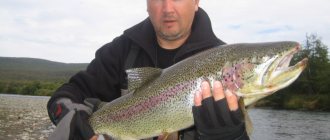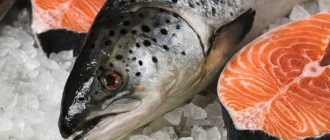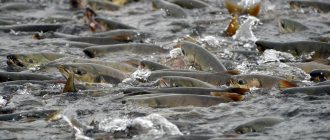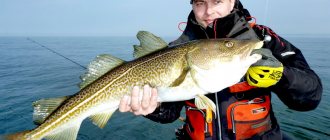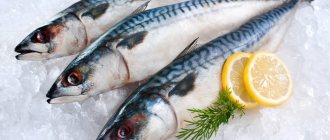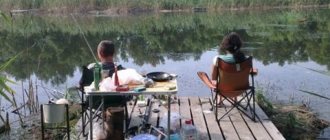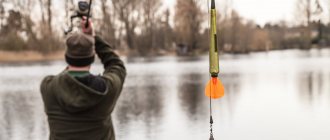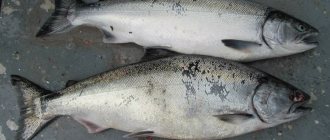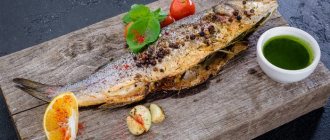Origin and description
Salmon belong to a group that appeared quite a long time ago: according to some sources, its ancestors originated on Earth millions of years ago. Although they took their current form much later. It is believed that about fifty species belong to this family.
The length of salmon can even reach up to two meters. At the same time, there are also species that are quite small - only twenty or thirty centimeters. The weight of this fish is also a serious indicator. For example, types of salmon such as taimen or salmon reach seventy kilograms.
Their structure is as close as possible to herring-shaped ones. The body, compressed laterally, is distinguished by the presence of a lateral line. Multi-rayed fins are located on the middle part of the belly, while there are no spiny rays on the pectoral fins. Characteristics of salmon are the spots that are its “calling card”. After all, even the name itself, which has an Indo-European root, means “to become covered in spots.”
Kinds
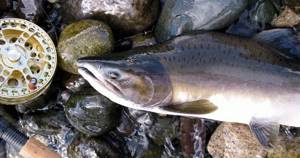
This family includes quite a few varieties. Among them are river or lake trout, for example, Sevan Ishkhan, Atlantic, the prominent representative of which is salmon, Siberian, char, and, of course, Pacific or Far Eastern salmon - pink salmon, chum salmon, etc.
Salmon species also differ in life expectancy. This is due to the unequal time of their freshwater period of existence. Hence the difference between species - in complex and sharply simplified age structures. Salmon is a fish that easily changes its lifestyle, its appearance and color, changing depending on conditions.
The meat of this sea creature tastes excellent, which is why many types of salmon have become targets for fishing.
Popular salmon fish and their description
It will be interesting and instructive for domestic fishermen to learn about those representatives of the salmon family that can be caught by an amateur fishing rod. Among them there are both trophy fish and small inhabitants of fast rivers.
Representatives of Siberian rivers
The three most popular representatives of the salmon family are found in Siberia. This is a large taimen, as well as its small relatives lenok and grayling.
Taimen
Taimen is found in rivers and large lakes of Siberia, Altai and the Far East.
This Siberian salmon can reach a length of over 1 m, and the weight of the giant reaches 60 kg. This fish is rightfully classified as a long-livers, since the age of individual individuals is 50 years. Note to anglers!
Taimen lives only in clean water, leading a solitary or paired lifestyle. It should be noted that the most catchy areas for fishing enthusiasts are the basins of the Amur, Lena, Yenisei and Lake Baikal rivers. In those regions where people mined gold, this fish, unfortunately, disappeared. A lot of taimen are still found in the hard-to-reach rivers of Yakutia and Evenkia. The main object of hunting for this predator is pike.
Currently, several varieties of taimen can be mentioned.
- The largest and most interesting for fishermen is the Siberian taimen. This is a typical freshwater fish with a large population and can grow up to 60 kg.
- Korean taimen has been poorly studied, and information about it is controversial.
- Until recently, Danube salmon was on the verge of extinction. However, recent research gives ichthyologists optimism.
- Sakhalin taimen, despite the common name, is not related to taimen. This is a migratory fish species, while all taimen are freshwater inhabitants.

Photo 1. Taimen.
Lenok
Lenok is widespread in Siberian rivers. In this species of fish, a distinction is made between blunt-snouted and sharp-snouted modifications. Lenka is abundant in the Far Eastern, Mongolian, Chinese and West Korean rivers.
Lenok lives in the upper reaches of cold and fast rivers. Small individuals up to 40 cm long and weighing up to 1 kg live in flocks. And large individuals up to 90 cm long and weighing up to 6.5 kg prefer to live alone.
There is some disagreement among ichthyologists regarding the species diversity of lenoks. There are basically two camps. One of them contains blunt-snouted representatives, and its competition comes from sharp-snouted relatives. While the former tend to feed on insect larvae, the latter specialize in rodents. The largest weight of lenok caught was 8 kg.
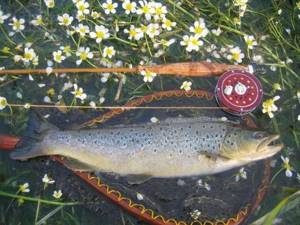
Photo 2. Lenok.
Grayling
This representative of salmon is distributed in all reservoirs of Siberia. Large populations are found in the tributaries of the Amur, Ob, Yenisei, Lena and Lake Baikal. All graylings differ in their coloring. Scientists distinguish 4 varieties:
- West Siberian;
- East Siberian;
- Kamchatka;
- American (Alaskan).
This is interesting! Black and white grayling live only in Baikal. In general, there are variegated, silver, and brown representatives of this subfamily.
Grayling is one of the smallest representatives of salmon. Having reached the age of 10 years, the fish is able to gain weight of about 2 kg and grow up to 50 cm.
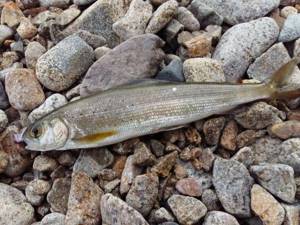
Photo 3. Baikal grayling.
Atlantic salmon
In addition to salmon, the group of Atlantic or noble salmon includes brown trout and trout.
- Salmon is considered one of the most delicious fish. This representative of salmon can reach 1.5 m in length and 45 kg in weight. The habitat of salmon is not limited to the Atlantic Ocean; the fish also thrives in the cold waters of the Arctic Ocean.
- Brown trout are also lovers of cold water, but this fish is more attached to freshwater areas. Even when at sea, she tries to stick to the coastal zone.
- Trout even resembles brown trout in appearance, which confirms their close relationship.
- In the south of the Atlantic, a Caspian population can be distinguished, some representatives of which gain weight of 50 kg.
The noble salmon that live in northern waters are very popular among fishing enthusiasts. Even in the Neva there are specimens weighing 40 kg.
Pacific salmon
Pacific or Far Eastern salmon comprise 6 species of fish that breed in freshwater bodies. In them, adult individuals die after spawning. Residents of the Far East especially value chum salmon and pink salmon.
- Pink salmon is the most abundant Far Eastern salmon. The distinctive features of this fish are the presence of round black spots on the caudal fin. If we compare pink salmon with other Pacific relatives, they have a thicker caudal peduncle. The fish cannot boast of its size; the length rarely reaches 75-80 cm, while the weight is limited to 5.5-6 kg. Before spawning, pink salmon changes color, it develops a hump, and the shape of its jaws changes.
- The second largest species of Far Eastern salmon is chum salmon. The size of an adult individual can reach 1 m with a weight of about 15 kg. Unlike other relatives, when entering fresh waters before spawning, the fish does not change in appearance.
- Pacific salmon also includes such well-known fish species as coho salmon, nelma and chinook salmon.
Loaches
In the salmon family, the loach is distinguished by its extremely small scales, which cannot be felt to the touch. The fish probably got its name for this feature. Loaches have another unique ability. Adapting to different conditions of reservoirs, they received variable colors. Scientists distinguish several forms depending on the habitat. There are river, lake, anadromous, arctic, etc. char. They are absolutely different from each other, but at the same time they are close relatives.
- The largest representatives of this species are considered to be anadromous loaches. They can grow up to 90 cm in length, gaining a weight of 15-16 kg.
- The lake form, called palia, rarely exceeds 50 cm, and the weight of the fish ranges from 0.3-1.5 kg.
- Arctic char began to be called those representatives that live in rivers flowing into the Arctic Ocean. This is a large fish, up to 88 cm long and weighing up to 16 kg.
Pacific salmon
This variety is known in our country under a different name. This is Far Eastern salmon. Its family includes six representatives who die after spawning. Most often, Far Eastern salmon in Russia is found in Kamchatka, the Kuril Islands and off Sakhalin Island. Far Eastern salmon is monocyclic. Soon after spawning in fresh water, this fish dies.
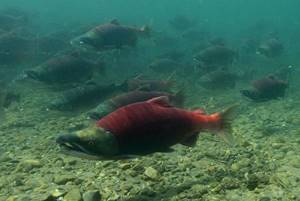
Far Eastern salmon are found throughout the northern Pacific Ocean, including the Sea of Japan, as well as the Sea of Okhotsk and the Bering Sea. It does not form large accumulations and remains in the upper layers, as a rule, up to a depth of ten meters. Salmon food is very varied. This can be small pelagic fish and their juveniles, crustaceans, pteropods, small squid, worms, sometimes even jellyfish and ctenophores. Fish from the Far Eastern genus during the marine period of life are covered with silvery, easily falling scales. There are no teeth on the jaws.
This is an anadromous genus, spawning in fresh waters and feeding in the sea. Six different representatives are known: pink salmon, red salmon, chum salmon, chinook salmon, coho salmon and masu salmon. Far Eastern salmon spawn only once in their entire short life, dying after spawning.
Far Eastern salmon
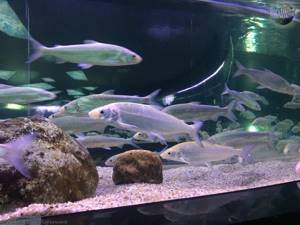
11899
This story will be about real self-sacrifice for the sake of procreation. This is what most salmon are. What is an anadromous fish? This is the one that is born in a small river and, while still practically a fry, gradually moves towards big water - into the ocean. There they live - feed, play, and then their inner nature calls them back, and the fish return exactly to the place where they were born yourself. This is where spawning will take place, and this is where their short life will end. Far Eastern salmon breed only in the fresh water of their native river, and after it ends, almost all the fish die: the road home is very long and difficult, the salmon are in such a hurry that they do not stop to feed.
People have not yet understood how they find the right path across many hundreds of kilometers. Maybe their sense of smell is so good, or maybe they remember the features of the magnetic field - who knows? Most likely, this is harmony with nature, with the water element, and the fish is an obedient child of its wild nature. The expanses of the Pacific Ocean, the cleanest rivers of the Far East, where fortunately for salmon there is not yet much human civilization, good food - phytoplankton in childhood, and then sea krill - all this helps salmon to accumulate enormous wealth, which people use for their health and longevity.
Wild Far Eastern fish - whitefish, lenok, taimen, char, chinook salmon, sockeye salmon, coho salmon, chum salmon, pink salmon - they all contain natural antioxidants and Omega-3 fatty amino acids in their meat. They help a person not to grow old, to keep the brain in working order with its good memory and focused attention. Laboratory mice that were constantly given salmon meat lived more than a third longer. Salmon also contains other benefits - vitamins B-1 and PP, chromium, phosphorus, potassium. This means that a person who loves fish will have strong teeth and bones, he will be full of energy and less tired, because the cell building processes will go well. This is especially useful for a growing body.
Pink salmon is rightly considered the most popular salmon. True, only males become humpbacked when they migrate to their native spawning ground, all the time moving against the rapid flow of Far Eastern rivers. In addition, pink salmon is the most numerous salmon in terms of distribution, population size, and fishing volume. In terms of taste, people cannot agree on primacy among salmon: the Japanese believe that it is Chinook salmon, the Far Eastern residents of Russia choose their char with its gray and incredibly tasty meat (they catch char no more than three months a year, this fish is, one might say, rare) or ketu is the most dietary meat among all others. The latter can be compared with artificially grown salmon or trout, which contain two hundred kilocalories per hundred grams of meat, while chum salmon, which swims huge distances every day in the vastness of the ocean, contains only one hundred and twenty-seven. And, of course, won’t the taimen, the largest of all members of the family, get the palm? Two-meter handsome and weighing up to eighty kilograms, not every fisherman will have such luck.
I would like to talk in more detail about Kamchatka sockeye salmon. This is the same salmon family; sockeye salmon also reproduce only once in their lives and after that they no longer live. It can be cold for a long time in Kamchatka, and also very cold. But many rivers do not freeze due to their fast flow. And so, at a moment when winter doesn’t even think of ending, and snow still lies everywhere, the river suddenly begins to boil, as if hot springs suddenly broke through the bottom. This salmon went to spawn. Instead of river waves, there are waves of fish backs, overcoming the current, shallow water, and rapids. Red-listed white-tailed eagles begin to flock along the shores; they also live in harmony with nature and know that now they will certainly have food. They anticipate prey; for now they do not pay attention to the fish rushing towards their fate. Why fight a strong fish now if it will die soon anyway? “Then we’ll feast!” - the eagles are probably thinking. They are waiting for the moment.
So the sockeye salmon set off on its way home up the river to give life to its offspring and then die. Several years have passed since she herself swam here into a new world unknown to her - to the ocean. Sockeye salmon is looking for the very place where its eggs once lay. It took the baby a whole year to gain strength, and another six months to get to the ocean. This is not so much; others do not have time to do it all in two years. Some never reach the ocean and die along the way - the path is dangerous. It was good on the ocean expanses, but the inexorable nature does not allow you to stay there forever. Sockeye salmon, like other fish, definitely need to take care of their offspring. And at the very peak of happiness, when the fish’s body is the strongest, healthiest and most energetic, this call of nature leads the sockeye salmon to the place of its birth.
This is an even more difficult path than the one she made when she was not yet a fully grown fish. It's hard to swim against the current, jumping over rapids and rocks. That’s when males develop a hump, sharp teeth, and the ability to defend themselves and protect their offspring. On the way, the fish do not eat anything, they are in a hurry, and therefore exhaustion occurs in both males and females. Finally, the sockeye salmon finds the very place where it was born. The female digs a hole at the bottom and lays her eggs in it. The males, carefully watching her, begin to fight tooth and nail, since only the winner will have the right to fertilize the laid eggs. Those evading the fight try to break through without permission, but the female fiercely defends her clutch.
Both males and females at this moment are absolutely defenseless: exhausted, busy with spawning, they invariably become prey for various predators. And while they are forced to crawl into shallow water over sharp stones during their journey home, they also die in large numbers: not only do birds of prey snatch them up, but for bears this is the time for a real feast. It is during salmon spawning that they regain their former strength after a long winter. There is no salmon - the bear may die. And after spawning, both males and females lose all strength, and very soon there will not be a single adult salmon left in this river. But what remains is the eggs, which the female carefully laid, the male watered with milk, the future fry were buried together, camouflaged and protected as long as they could. Soon, soon a new life will be born, the larvae will hatch, then turn into fry, grow up and move out into the open - to the ocean. This is the life cycle of salmon.
Text: Lyudmila Garkavaya
Tags: fish salmon
Spawning sites
Sexually mature males and females of the same age “put on” their mating plumage. They acquire a special body shape and color. For spawning, they choose mainly deep-water sections of rivers, where the current is fast. Far Eastern salmon such as Chinook salmon use quite specific places for spawning. This may be a place in front of a riffle that has sufficient depth, and in front of fast flowing water, especially in the upper reaches of rivers in Kamchatka.
During spawning, Far Eastern salmon can also enter lakes with sand and pebble soil with a well-defined under-channel flow. Pink salmon and chum salmon breed in small tributaries or upper reaches of rivers, choosing areas downstream.
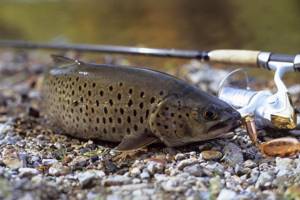
Spawning period
When going in search of salmon during the spawning period, it is worth familiarizing yourself in advance with which places this fish prefers for spawning. Sexually mature individuals (4-6 years old) change their color during spawning, the scales become darker, and in some species even teeth appear. Salmon spawn at different times of the year, depending on the species. For example, representatives of the “spring” form go to rivers in June and September, and “winter” varieties in November and April.
The favorite places of the Far Eastern representatives of salmon fish during the spawning period include:
- deep-water sections of rivers,
- rifts in the upper reaches of Kamchatka reservoirs,
- river areas with fast currents,
- lakes with a sandy and pebble bottom, where there is a strong under-channel current,
- small river tributaries and headwaters.
Fast-flowing rivers become excellent places for spawning chinook and coho salmon. Quieter areas, as well as lakes, serve as a refuge for pink salmon and chum salmon.
What is surprising is that during migration from the seas and oceans, fattened Far Eastern salmon do not feed. Sometimes it rises several hundred kilometers along the river. The source of food, vitamins and nutrients are the reserves that accumulate in muscle tissue.
To form a clutch, females choose reservoirs with a pebble bottom or sand, where they lay fertilized eggs.
The spawning fish constantly stays against the current and scatters the underwater soil with its tail. Due to the fact that the process of migration and spawning takes a lot of energy from the fish, it dies almost immediately on the spot after spawning. In some cases, weakened fish are carried by the river current to the mouth, where they die. Mass deaths of salmon are often observed by residents of Far Eastern Russian cities; this phenomenon is called the “wall”.
Features of spawning
During migration to spawning grounds, this fish does not feed. It exists solely due to the reserve accumulated in the muscles, therefore it is extremely depleted along the way.
During spawning, Far Eastern salmon bury fertilized eggs in the ground, so they lay them in places where the bottom is not silted, but covered with pebbles or gravel. The female, surrounded by one or several males, holds her head against the current, scattering the soil with strong movements of her tail. After spawning, there is a massive mortality of salmon. The most emaciated individuals die already at the spawning site, while others are carried by the current, where they die on the road to the mouth.
Often the bottom and river banks are literally covered with dead fish. In the Far East, this phenomenon is called “snenka”. Crows, seagulls and a wide variety of animals, including bears, flock to such abundant food.
Pink salmon
This is the most numerous representative of the Far Eastern salmon. Pink salmon is somewhat different from other varieties. For example, its last fin has round spots of black, while the caudal peduncle is much thicker. In addition, pink salmon are relatively small in size. This fish rarely grows more than eighty centimeters in length, and weighs up to five and a half kilograms.
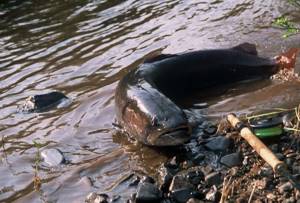
"Noble" look
This most famous salmon - salmon - reaches a length of one and a half meters, and a weight of almost forty kilograms. The meat of this fish is highly valued, especially when it has already become fat before spawning. This species spends most of its life in the sea. For example, this salmon in Karelia, where it is found in Lakes Onega or Lake Ladoga, may form a separate subspecies. At the same time, in the sea, salmon prefers to stay close to the shore.
She has an oblong body with very small silvery scales. The back is usually darker, with a bluish tint. The fins are quite short: the dorsal and caudal fins are gray with a brownish tint, and the rest are light. The salmon's head is somewhat elongated, and its wide mouth contains many strong teeth. Atlantic salmon, or salmon, like all other representatives of the species, has a characteristic adipose fin.
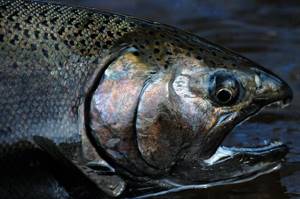
Lenok
This fish is represented by two distinct forms - blunt and sharp-snouted. They differ not only in their appearance, but also in their eating preferences. For example, blunt-snouted ones prefer to feed only on insect larvae, while sharp-snouted ones prefer to eat rodents.
Far Eastern salmon lenok is widespread in Siberia and the Far East in lakes and rivers. There is a lot of it in Mongolia, as well as in Western Korea and China. There is none west of the Urals. Lenok prefers cold, fast rivers, especially their upper reaches.
Large specimens live alone, while smaller ones gather in small flocks. Lenok grows up to six to seven kilograms and ninety centimeters in length.
It is growing at a slow pace. The shape of its body is similar to a whitefish - with small but dense scales, rough in appearance. The color of the lenok expresses the living conditions of this fish: on the back and sides there is a dark brown color with numerous dark spots. The abdomen is light.
When spawning maturity occurs, red specks appear on the lateral parts of the body. Lenok can live up to fifteen years, reaching sexual maturity by the fifth year. This salmon spawns at a depth of up to one and a half meters in May or June.
What are the prospects for the project?
Likhachev found it difficult to assess how suitable the area in Vityaz Bay acquired by Russian Aquaculture is for raising salmon in artificial conditions, but noted that the depth there is comfortable enough for the development of aqua and mariculture.
If we were talking about a project for growing Atlantic salmon or sea trout in the Barents Sea, then investments in production with a capacity of 4.5–5 thousand tons of products per year would amount to about 3 billion rubles at the first stage, estimates the managing partner of Agro & Food Communications Ilya Bereznyuk. The expert found it difficult to estimate the potential volume of investments in the project in the Far East: the climatic conditions of this region are different and may not be suitable, for example, for growing salmon. As for mariculture, launching one specialized farm for growing up to 250 tons of commercial mussels can cost an investor an average of 10–15 million rubles, Bereznyuk estimated. According to him, three such farms are needed for a full production cycle—capital costs for a project with a capacity of up to 750 tons will be about 40–50 million rubles.
The idea of now growing aquaculture salmon in the Far East, where there is enough wild fish, according to Likhachev, does not look wild, since natural resources are being depleted. All over the world, industrial fish farming, that is, growing fish in so-called cages, is taking up more and more space in fish reproduction, he explains. The demand for high-quality seafood is growing, in particular in China, so the production of aquaculture salmon in the region may be promising, Likhachev sums up.
There are sea farms in the Far East, but they mainly grow shellfish - mussels and oysters, Fomin noted. He doesn’t remember full-cycle enterprises that grow salmon here, but notes that artificial fish reproduction is widespread in the region. Salmon - pink salmon, chum salmon, sockeye salmon or coho salmon - enter fishing grounds located in rivers to spawn, from the eggs of these fish fry emerge, which are fed and released back into the ocean in the spring, so that they then return to spawn in the same river, explains Fomin .This approach guarantees the conservation of fish stocks.
The plot that Russian Aquaculture acquired, according to Fomin, may be more promising from the point of view of growing mariculture - this business is simpler, and it will pay off faster, since the costs of mariculture farms are low compared to salmon farming. But salmon farming, according to Fomin, also has prospects: for example, a company can, following the example of enterprises in Japan, stock young wild salmon in the Far East - coho salmon, and then transport it and raise it on farms in the Barents Sea, where conditions for this are more favorable.
Taimen
This subspecies is found in almost all large rivers and lakes in Altai, the Far East and Siberia. Taimen is a predator that grows up to one meter in length and weighs up to sixty kilograms. Among other representatives, this fish from the genus of Far Eastern salmon is a long-liver, living up to fifty-five years.
Small specimens have up to ten transverse dark stripes on the sides, as well as dark x-shaped spots. During the spawning period, the body of taimen turns copper-red.
This salmon lives exclusively in clean water and is considered an ideal predator. He feeds on fish, although sometimes he is not averse to snacking on rats, squirrels, and mice swimming across the river.
Taimen is not subject to fishing. It never moves in a flock, living in deep channels or under riffles in pairs or alone. The most catchable habitats of large taimen are the basin of Lake Baikal, the Amur, Yenisei, and Lena rivers. In the mountain rivers of southern Siberia and northern Sayan, large specimens are caught very rarely. Moreover, for many kilometers around such large cities as Yakutsk, Ulan-Ude, Krasnoyarsk, Irkutsk and others, taimen have not been found for a long time. The quality of the meat of this fish improves towards the north.

External signs of common species
Any fisherman needs to be able to distinguish all varieties of Far Eastern salmon fish from each other. This information will be especially useful if you want to catch a specific species while fishing. Each fish has its own distinctive features. Habitats also vary. What are the external signs of the most common salmon-like underwater inhabitants of Russian rivers:
- Pink salmon is the most common species, which is significantly different in appearance from other Far Eastern salmon fish. The last fin of pink salmon has pronounced rounded dark spots. The tail of the fish is quite thick relative to its small body. Rare specimens of this red fish can grow up to 80 cm and weigh about 5.5 kg.
- Chum salmon is another common representative of Pacific salmon, differing from the previous species in the absence of characteristic spots. During spawning, males and females practically do not change color. An adult can reach 1 meter in length. The weight of mature fish does not exceed 15 kg.
- Salmon is a valuable commercial species, which is a type of Atlantic salmon. Adult fish are particularly large in size. Body length reaches 1.5 meters. The weight of an adult fish is no more than 40 kg. Salmon spends most of its life in lakes and seas and often washes up on the shore. The body of the fish has an oblong shape, the scales are silvery. The scales on the back are dark in color with a bluish tint. The fins located on the back and tail are brownish in color. The main distinguishing feature of the species is the adipose fin.
- Lenok - found in two forms: with a blunt and sharp stigma. The blunt-snouted representatives of the species feed on insect larvae, while the sharp-snouted ones do not disdain even small rodents. The Far Eastern lenok is found in rivers and lakes of Siberia and leads a solitary lifestyle, rarely forming flocks. The scales of this fish are small and dense, and due to the fact that the lenok prefers cool water bodies to live in, its body has a characteristic color - a dark back, brownish sides with black spots, and a light belly. During spawning, the fish becomes covered with red specks.
- Taimen is widely distributed in rivers and lakes of the Altai Territory, Siberia, and the Far East. Fishing for taimen in the waters of Baikal, Amur, and Yenisei promises a good catch for every fisherman. The predatory fish boasts large sizes. The body length of an adult fish reaches 1 meter. Trophy specimens weigh 6-7 kg. Small fish differ from large ones by the presence of dark transverse stripes and spots. Spawning fish completely change their silver color to copper-red. Taimen feeds on small rodents, mollusks, and fish.
It is worth noting the fact that, regardless of the type of Far Eastern salmon, the quality of the meat of the caught fish improves towards the north.
Atlantic salmon
The lifestyle of this family is practically no different from that of Pacific or Far Eastern salmon. This species includes the Baltic, Caspian and Black Sea varieties, as well as salmon, trout found in streams and lakes, and brown trout. The latter, in particular, prefers to live in the northern seas, although it has a great affinity for fresh water. Even when this species of Atlantic salmon is in marine waters, it continues to stay close to the shore. As for trout, experts believe that it originated from brown trout. This is due to their external similarity.
